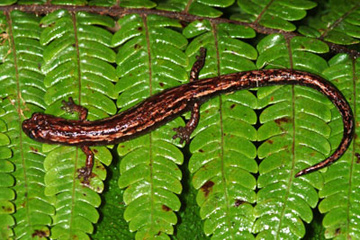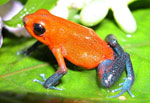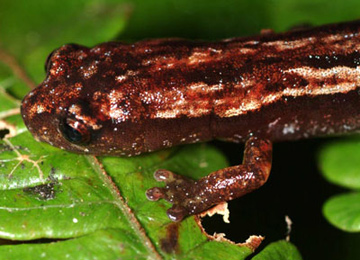Two new species of salamander discovered in Panama
Two new species of salamander discovered in Panama
mongabay.com
September 9, 2007
|
|
Scientists have discovered two new species of salamanders from the mountainous Costa Rica-Panama border region. The findings, published by David B. Wake, Jay M. Savage, and James Hanken in the journal Copeia, push the number of salamanders known in the region to 24, making it a hotspot in terms of salamander biodiversity.
Both species are small, slender salamanders that belong to the Bolitoglossa genus and apparently live in tropical montane forest habitat. The salamanders have prehensile tails and appear to be good climbers.
The first species, Gomez’s Web-footed Salamander (Bolitoglossa gomezi), was named in honor of Dr. Luis Diego Gomez, a Costa Rican botanist who was formerly Director of the La Selva Biological Station of the Organization of Tropical Studies. The second species, Brame’s Web-footed Salamander (Bolitoglossa bramei) was named in honor of the late Arden H. Brame, Jr., II, in “recognition of his many contributions to the study of Neotropical salamanders.”
 A paratype of Bolitoglossa gomezi that appears in Wake et al. (2007). Photo by Dr. Alan Jaslow of Rhodes College |
Dr. James Hanken, a herpetologist and Director of the Museum of Comparative Zoology at Harvard University, says that while the discovery of new species is encouraging, salamanders and other amphibians are declining in Central America.
“New species of tropical salamanders from South and especially Central America continue to be discovered and described at a remarkably high rate. Species density is very high in some areas, such as the mountainous border region between Costa Rica and Panama, which we address in this paper,” he told mongabay.com. “At the same time, many new species, as well as many of those known for a long time, have suffered dramatic population declines over recent years. Several species have not been observed alive in nature for several years, despite intense and repeated efforts to find them.”

|
While it is still unclear why tropical salamanders are disappearing, a leading culprit for declining amphibians in the region and worldwide is the outbreak of chytridiomycosis, a deadly fungal disease. Some scientists believe that climate change may be worsening the outbreak by creating conditions that favor the infectious skin disease.
Other researchers say that pesticide use may specifically be affecting montane amphibian populations. In January a study led by Frank Wania of the University of Toronto found that pesticides used in lowland areas are carried by air currents to higher elevations where they are they precipitated out as rain when the air cools. The chemicals — especially the insecticide endosulfan and fungicide chlorothalonil — then accumulate in the ecosystem, potentially affecting montane forest biodiversity.
Regardless of the proximate cause, most scientists agree that amphibian populations are fast-declining. A 2006 study found that almost two-thirds of the 110 known harlequin toads (Atelopus) Central and South America went extinct in the 1980s and 1990s, while the Global Amphibian Assessment, a comprehensive status assessment of global amphibian biodiversity, classifies one-third of the world’s nearly 6,000 known amphibian species as being at risk of extinction.
In a last-ditch effort to save some of the world’s most threatened species, a coalition of zoos, aquariums, botanical gardens, and scientists have launched an appeal to raise hundreds of millions of dollars to set up captive-breeding facilities. The project, dubbed the Amphibian Ark, has declared 2008 “The Year of the Frog.”
CITATION: David B. Wake, Jay M. Savage, and James Hanken (2007). Montane Salamanders from the Costa Rica-Panamá Border Region, with
Descriptions of Two New Species of Bolitoglossa. Copeia, 2007(3), pp. 556-565
Related articles
 |
Frogs avoid damaging UV-B radiation, reducing extinction risk
(4/18/2007) Poison arrow frogs appear to make special effort to avoid exposure to damaging ultraviolet-B radiation, according to research published in the journal Biotropica. The findings are significant in light of increasing levels of UV-B radiation due to ozone depletion.
 |
Bad news for frogs; amphibian decline worse than feared
(4/16/2007) Chilling new evidence suggests amphibians may be in worse shape than previously thought due to climate change. Further, the findings indicate that the 70 percent decline in amphibians over the past 35 years may have been exceeded by a sharp fall in reptile populations, even in otherwise pristine Costa Rican habitats. Ominously, the new research warns that protected areas strategies for biodiversity conservation will not be enough to stave off extinction. Frogs and their relatives are in big trouble.
Frog extinction crisis requires unprecedented conservation response
(7/6/2006) The world’s leading amphibian experts are calling for dramatic steps, including the formation of an Amphibian Survival Alliance (ASA), to prevent the massive extinction of amphibians worldwide. Scientists say amphibians — cold-blooded animals that include frogs, toads, salamanders, newts and caecilians — are under grave threat due to climate change, pollution, and the emergence of a deadly and infectious fungal disease, which has been linked to global warming. According to the Global Amphibian Assessment, a comprehensive status assessment of the world’s amphibian species, one-third of the world’s 5,918 known amphibian species are classified as threatened with extinction. Further, at least 9, and perhaps 122, have gone extinct since 1980.
Salamanders dying due to common pesticide
(3/25/2007) Atrazine, one of the most widely used pesticides in the United States, may be killing salamanders, according to American biologists writing in the journal Environmental Health Perspectives.
Salamander diversity tied to elevation in the tropics
(2/13/2007) Scientists have long documented high levels of biodiversity at mid-elevation ecosystems in the tropics, but no one has ever conclusively determined the underlying causes of this species richness. A new study, which examined 13 genera and 137 species of tropical salamanders, suggests that this pattern may result from the time when the habitats were first colonized.
